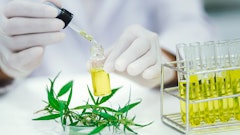
As the cannabis industry continues to evolve, market pressure will increase on businesses to adopt standardized methods to improve product safety, consistency and predictability. To do this, cannabis companies should consider the business modes of consumer packaged goods (CPG) companies, according to Shehzad Hoosein, executive vice president of Cannabistry Labs, a cannabis research, development and branding company.
“Companies in this industry really need to start thinking about themselves as CPG companies, as food and beverage companies, so that in their production [and] management, that’s the philosophy that they’re employing, where they have this almost paranoid focus on safety and quality,” Hoosein says. “It should be no different than making a Dorito at a Frito-Lay plant, where the entire organization there is all geared toward one goal and one goal only—to make a safe and high-quality food product.”
In order to achieve this level of safety and quality, he says, companies should build teams that either have backgrounds in the food, beverage and pharmaceutical markets, or that undergo the same training and follow the same standard operating procedures as teams in those industries.
“[By] bringing the folks in who can institute this culture of quality and safety, who can then train incoming employees on what they need and run a tight ship that way, you’re going to see a higher level of confidence in products that are coming out onto the shelves,” Hoosein says.
Adopting FDA standards in the production of cannabis-infused foods and beverages can also help improve safety, he adds.
“The FDA has already done most of the work … in defining what ingredients are safe for use in foods and beverages and the usage rates of those ingredients,” Hoosein says. “The cannabis industry, when we look at the regulations, doesn’t seem to have any way to enforce whether the ingredients that are being used in food and beverage are safe from an FDA point of view and [whether they] are being used at the usage rates that we have tested and know to be safe.”
Companies should follow FDA guidelines as if the FDA is actually auditing the cannabis industry, Hoosein says, to ensure they are using safe and high-quality ingredients in their products. For example, manufacturers can look to the FDA’s Generally Regarded as Safe (GRAS) designation to see which food and beverage ingredients and additives have been tested and approved.
In addition, to improve safety in overall production procedures, cannabis companies can look to Good Manufacturing Practices (GMP), which have been outlined to ensure safety in food production.
Companies should follow FDA guidelines as if the FDA is actually auditing the cannabis industry, Hoosein says, to ensure they are using safe and high-quality ingredients in their products. For example, manufacturers can look to the FDA’s Generally Regarded as Safe (GRAS) designation to see which food and beverage ingredients and additives have been tested and approved.
In addition, to improve safety in overall production procedures, cannabis companies can look to Good Manufacturing Practices (GMP), which have been outlined to ensure safety in food production.
“If you go into a Frito-Lay factory and there’s a Dorito line running there, there are protocols and practices that follow the GMP requirements to a tee,” Hoosein says. “In a company like Frito-Lay, if you’re deviating from these practices [and it’s] going to cause risks for the safety of the food, it’s a really big deal. … I haven’t really seen that in [the cannabis] industry.”
Hoosein points to testing as another area of the industry that needs standardized practices. While states with regulated cannabis markets have rolled out fairly robust testing regulations that require products to undergo pesticide, microbial and residual solvent testing, there is no standardized testing methodology across licensed labs.
“The issue we have today is that there is no one standardized way of testing potency on cannabis,” Hoosein says. “When you buy a cup of coffee and it says on your packaging, 250 mg of caffeine, you can be very, very sure that it actually does contain 250 mg of caffeine, no matter where it was tested, because there is a standardized method, globally accepted, for how caffeine is tested. … In the cannabis world, that universal method does not exist, and so everyone uses their own method that they’ve developed in-house. Some of them are close to each other, but quite honestly, some of them are very, very different.”
AOAC International is trying to develop standard, widely accepted testing methodology for the cannabis industry, Hoosein says. In addition, ASTM is working on standardized Quality Protocols and applicable GMP’s. Amongst other ways, this involves labs publishing their methods and having them peer reviewed.
“We’re still very much in the infancy of that process, and there are some phenomenally smart people out there that are trying to push this forward because they, just like us, realize that that’s really the foundation of making sure that when we say something is in it at this concentration, that it really is,” he says. “So, that work is happening.”
In the meantime, however, cannabis companies are at the mercy of third-party labs that all employ their own in-house testing methods.
“We are dependent on these third-party testing labs because the state requires you to send it to them,” Hoosein says. “There are some good ones and some that are just not accurate, but there’s no way to call them out because there’s no agreed upon method.”
Some states, such as California, have mandated that all labs be ISO 17025 accredited, which Hoosein says is a step in the right direction.
“ISO is a global organization that … sets very clear guidelines for how testing labs must operate,” Hoosein says. “It standardizes their practices, their processes, [and] all the documentation and controls that they need to have in place. … I think we’re seeing good results from that. I would probably endorse that and say most states should then think about putting in some standard for how third-party testing labs must operate, such as ISO.”
Implementing these standardized practices will not only improve product safety and quality in the industry, but also consistency and predictability, Hoosein adds. In order to create a predictable experience every time, a manufacturer must not only implement standardized processes, but also know how the product’s ingredients work together to deliver an experience to the consumer.
“It’s not just the CBD or the THC or the cannabinoid alone that has to do all the work here,” Hoosein says. “We’ve paired the THC and the CBD with … other ingredients that themselves have a certain efficacy for consumers. For example, in one of our sublingual tinctures, Go, under The Root of it All brand, … we’ve used a sativa-based THC in the formula, but we’ve paired that with ginger, rosemary and cardamom, each of which have their own efficacy toward driving energy and warmth in consumers. We’ve created a very predictable experience here because we didn’t just rely on THC alone. We’ve paired it and combined it in a synergistic way with other ingredients that all drive towards a similar kind of outcome, and because it’s a formulated product, we’re able to deliver a very consistent experience time after time with consumers. That’s another example of how, through food science, you can use the THC [or CBD] very strategically as an ingredient that when combined with others, gives you a very holistic, predictable and condition-specific experience."

























